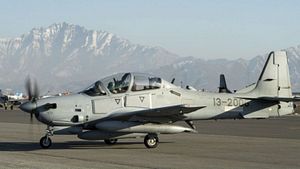After repeated delays including a contract cancellation, the first four out of 20 Embraer/Sierra Nevada Corporation A-29 Super Tucano light attack aircraft slated for service in the Afghan Air Force (AAF) arrived on January 15 at Hamid Karzai International Airport, IHS Jane’s Defense Weekly reports.
The AAF is expecting an additional delivery of four more A-29 Super Tucano by the 2016 fighting season, with an additional four delivered in 2017. The remaining eight will be handed over to the AAF by the end of 2018.
“The A-29 light attack aircraft is a versatile aircraft that brings a number of critical capabilities to the AAF. These include close air support, armed escort, and armed overwatch,” according to NATO’s ‘Resolute Support’ Mission spokesperson, Colonel Michael T. Lawhorn.
The four aircraft will become operational within the next couple of days and will, in all likelihood, be deployed to support combat operations in the eastern province of Nangarhar and the southern province of Helmand, according to Afghanistan’s acting Defense Minister, Masoom Stanikzai.
The United States Air Force (USAF), responsible for the training of Afghan pilots, allocated $427 million for the A-29 Super Tucano planes under the USAF’s Light Air Support program. One hour of flying time usually only costs $1,000, a big cost advantage for the cash-strapped AAF.
The A-29 Super Tucano is a turboprop aircraft specifically designed for counter-insurgency operations and can be equipped with a wide array of bombs (including precision guided munitions) and machine guns. According to IHS Jane’s Defense Weekly:
The A-29 features two internally mounted .50 cal machine guns (one in each wing), and has five hardpoints under the wing and a fuselage that can carry up to 1,500 kg of additional weapons. These can include .50 cal or 20 mm gun pods, rocket pods, short-range air-air missiles of the AIM-9X class, and conventional or smart freefall bombs. The aircraft’s inboard stations, as well as its ventral one, are also ‘wet’-configured for underwing fuel tanks.
According to the Afghan Ministry of Defense, the four A-29 delivered on January 15 will be all capable of dropping laser-guided bombs.
Brazilian aircraft maker Embraer and its U.S. partner Sierra Nevada Corporation where initially awarded the contract to supply 20 A-29 light attack aircraft in 2011. However, the contract was cancelled in 2012 due to a dissatisfaction of USAF leadership “with the quality of the documentation supporting the award decision.” However, the contract was re-awarded to Embraer and Sierra Nevada Corporation in 2013.
“In hindsight, I wish we would’ve started that years ago,” the commander of U.S. Forces in Afghanistan, General John F. Campbell said in front of the U.S. House of Representatives Armed Services Committee in March 2015, yet “we are where we are. (…) Quite frankly, we can’t get it out there quick enough for them.”
The first eight Afghan A-29 Tucano pilots graduated in December 2015 from flight school in the United States. Up to 30 Afghan pilots will be trained by the USAF over the next three years. The training program has been suffering from occasional desertion of AAF personnel. Most recently, two AAF members from a maintenance crew undergoing training at Moody Air Force Base in Georgia went missing in December 2015.
































